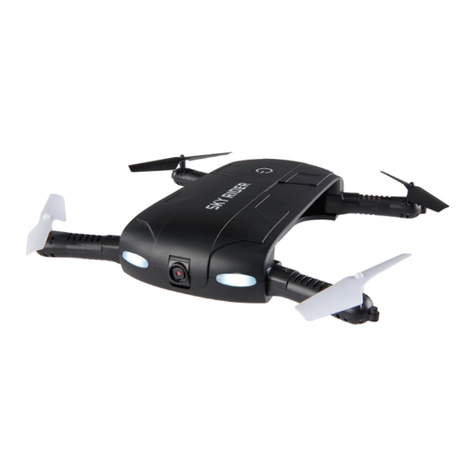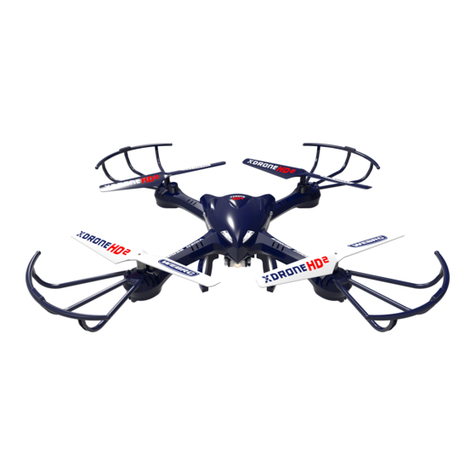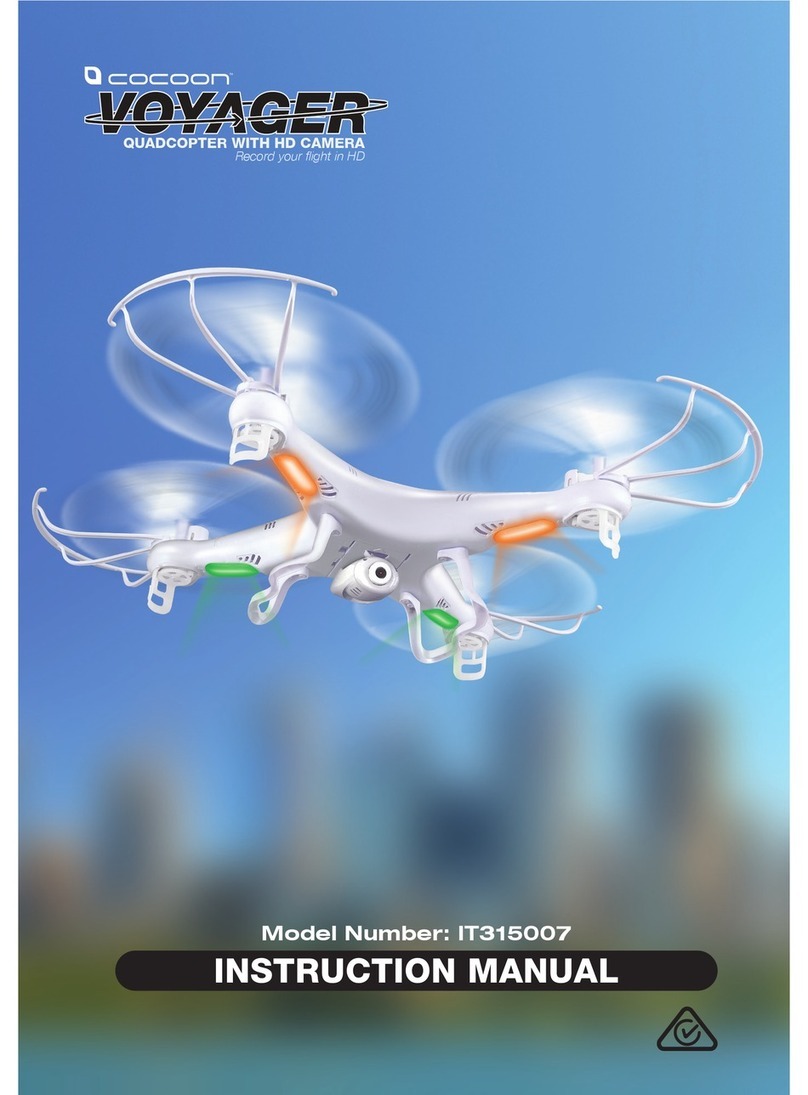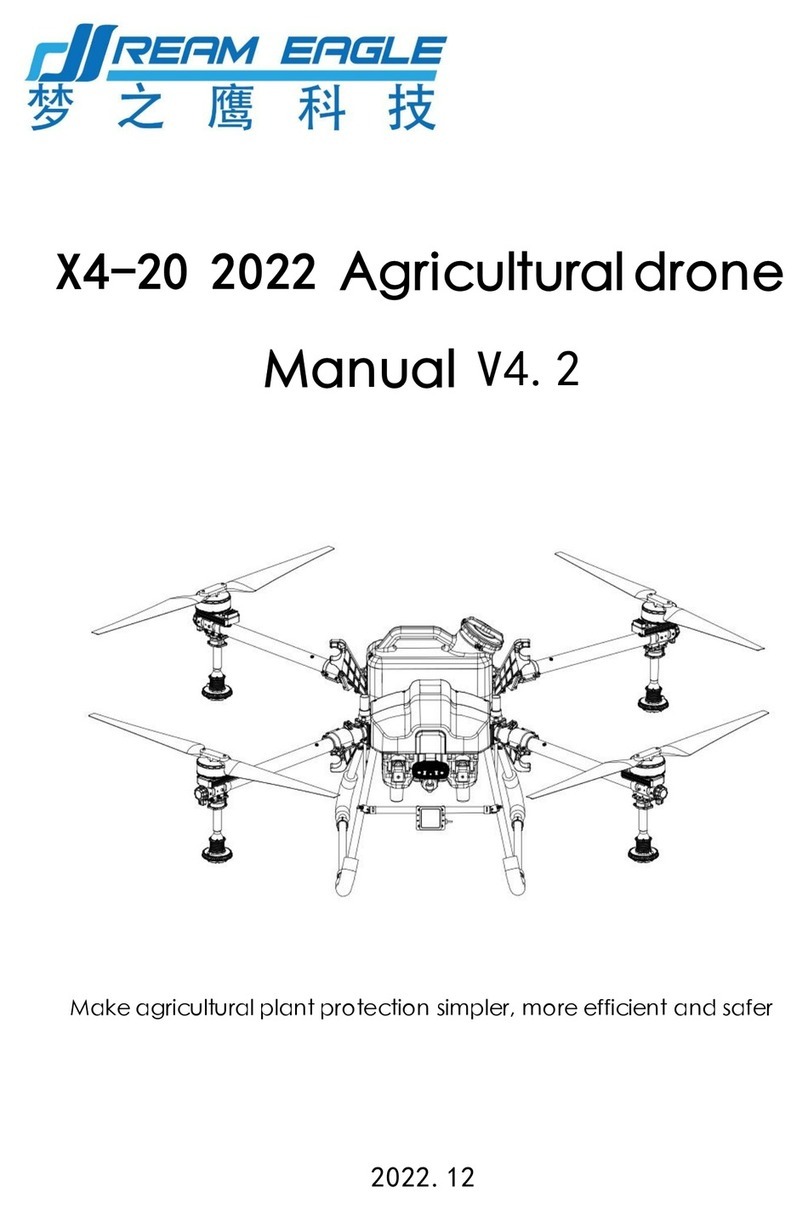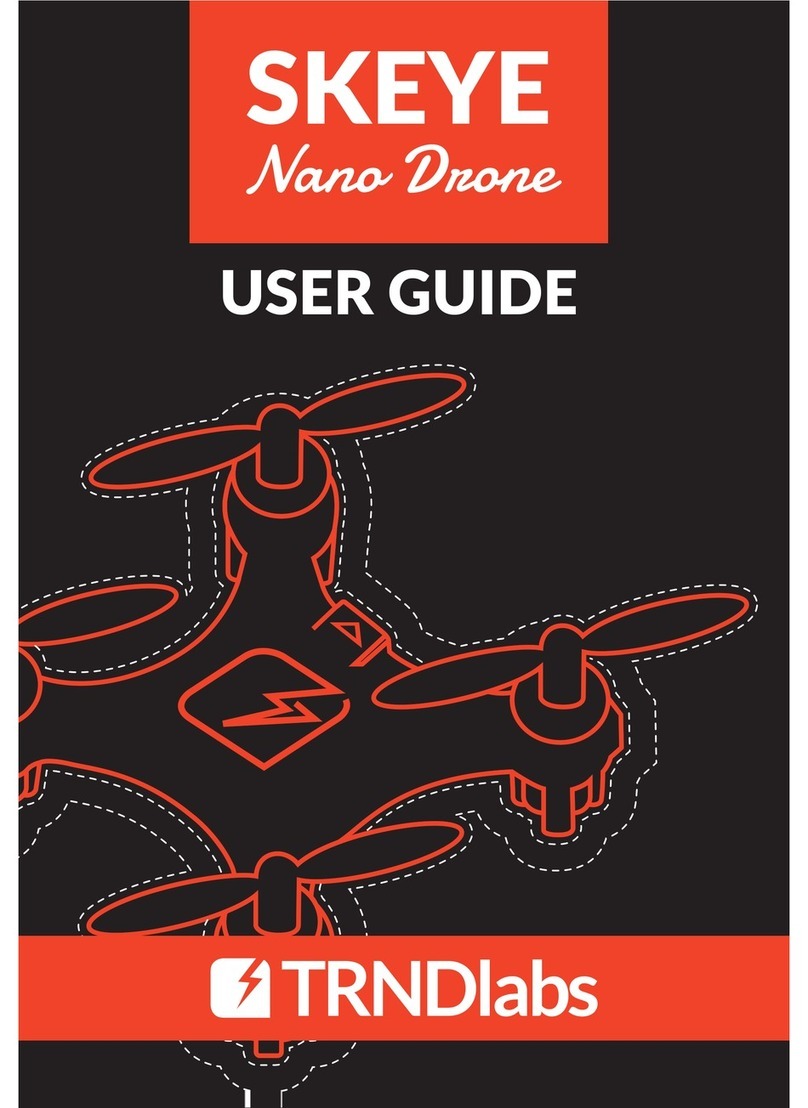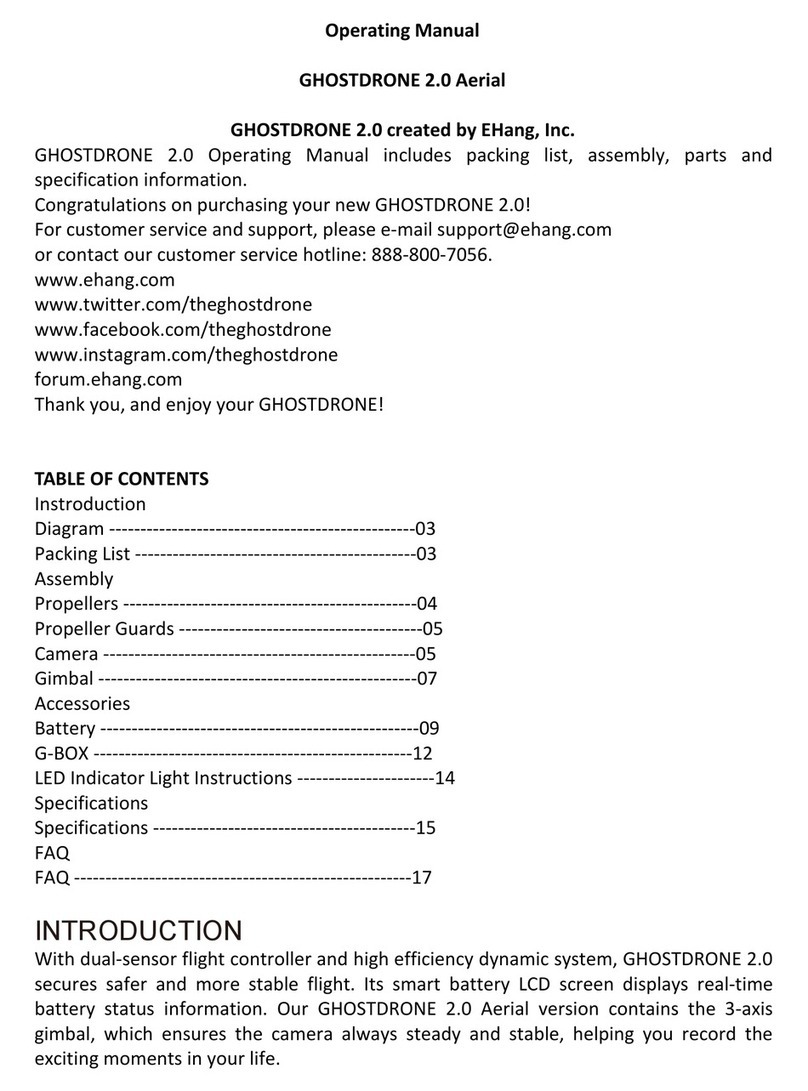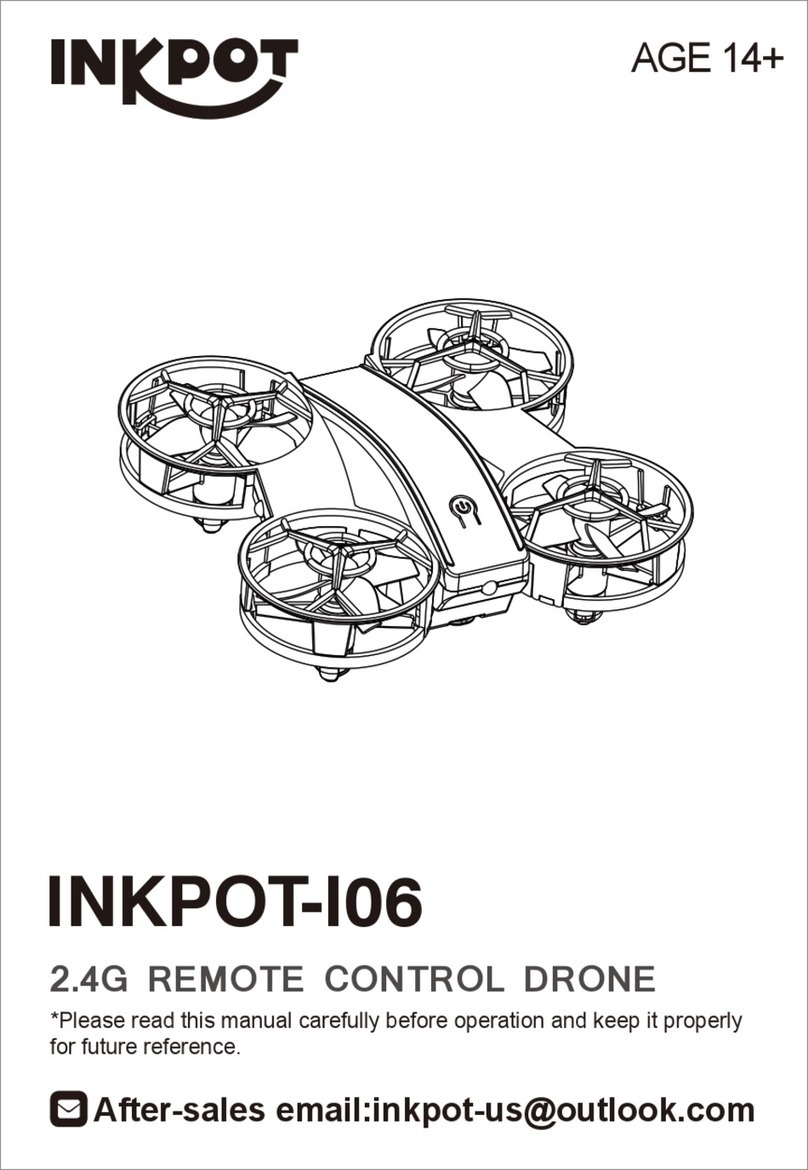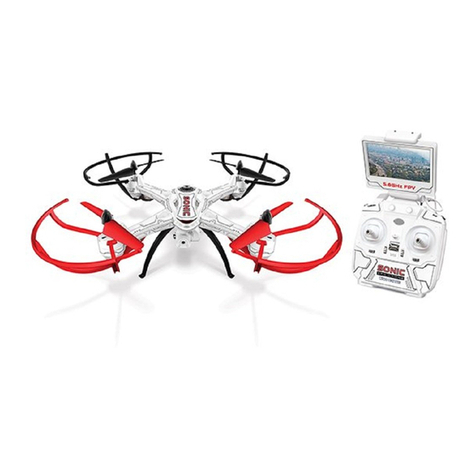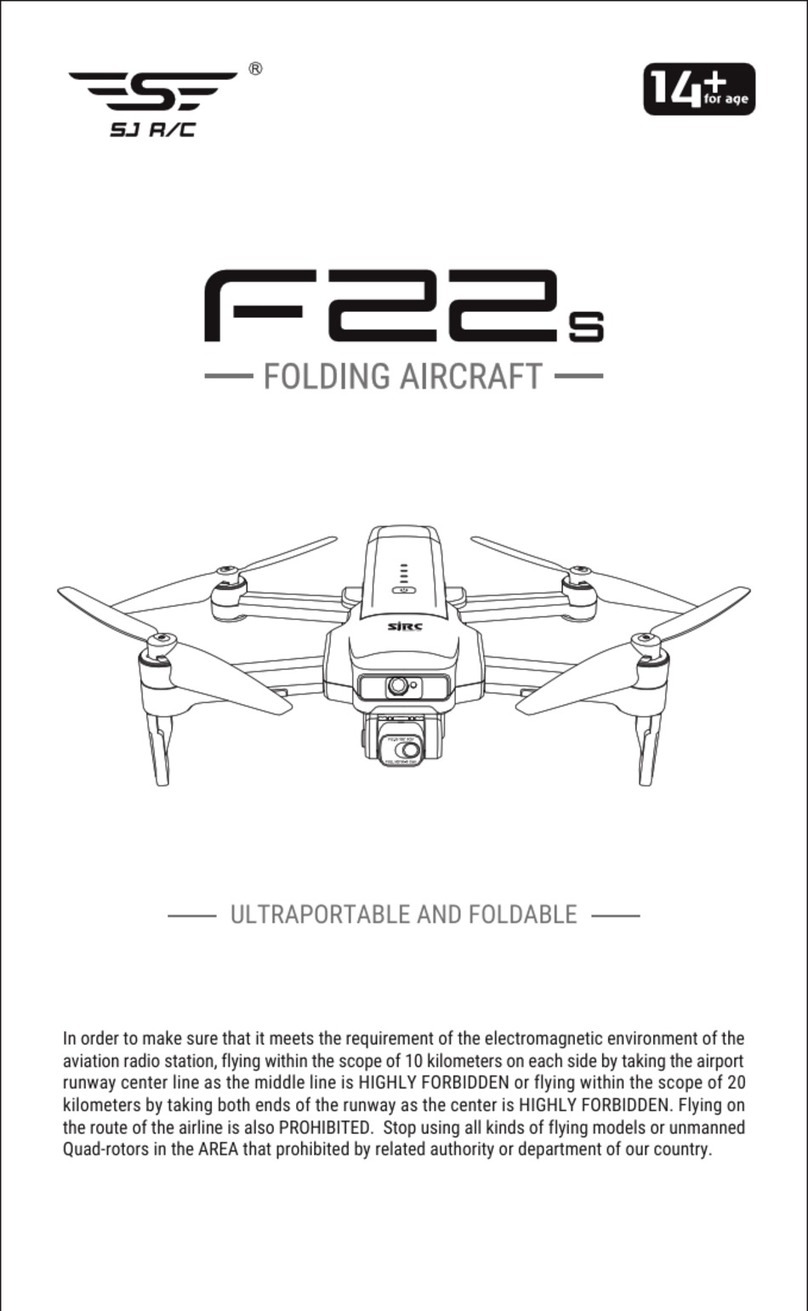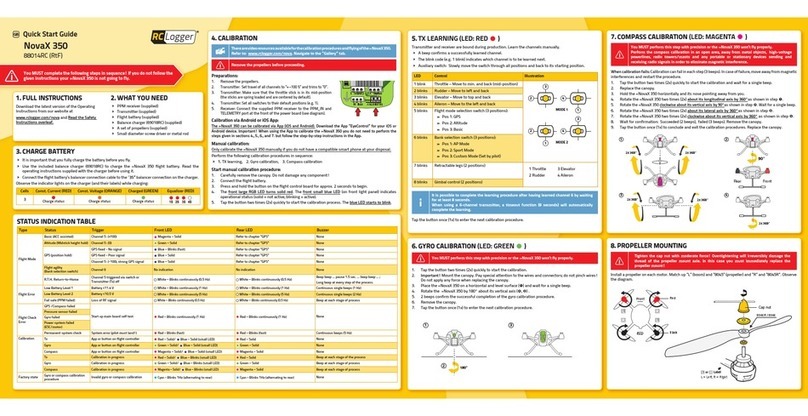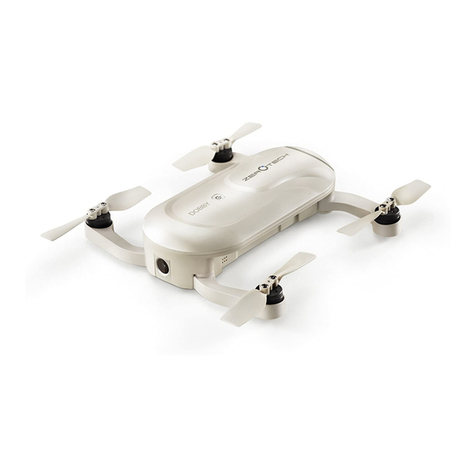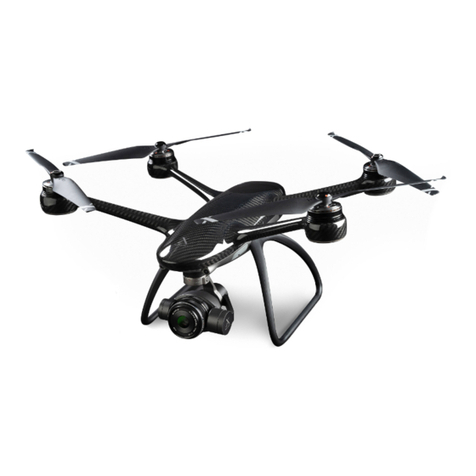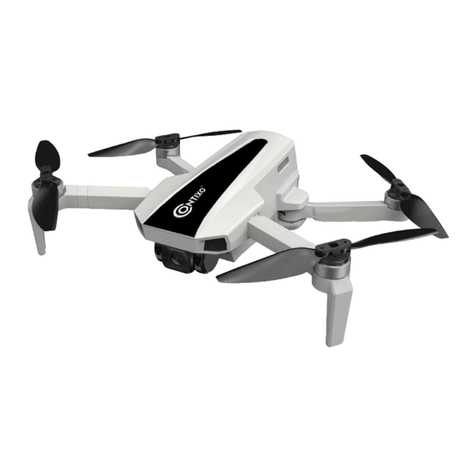M1 Drones M1 STEM Drone Series User manual


Rogue Version Micro User Manual (RV
Micro) v.2.0.1
High Performance, 3-D Printed, Sustainable,
Ultra-Lightweight, and Extremely ersatile
Michael A. Gruener
www.M1DRONES.com

NO
TICE
All instructions, warranties and other collateral documents are subject to change at the sole discretion of M1
DRONES LL . For up-to-date product literature, visit M1DRONES.com and click on the support tab for this product.
Meaning of Special Language
The following terms are used throughout the product literature to indicate various levels of potential harm
when operating this product:
NOTICE:
Procedures, which if not properly followed, create a possibility of physical property damage AND possibility
of injury.
CAUTION:
Procedures, which if not properly followed, create the probability of physical property damage AND
a possibility of serious injury.
WARNING
: Procedures, which if not properly followed, create the probability of physical property damage,
collateral damage, and serious injury OR create a high probability of superficial injury.
WARNING:
Read the ENTIRE instruction manual to become familiar with the features of the product before
operating. Failure to operate the product correctly can result in damage to the product, personal property and
cause serious injury or death.
This is a sophisticated product. It must be operated with caution and common sense and requires some basic
mechanical ability. Failure to operate this product in a safe and responsible manner could result in injury or
damage to the product or other property. This product is not intended for use by children without direct adult
supervision. Do not use with incompatible components or alter this product in any way outside of the instructions
provided by M1 DRONES LL . This manual contains instructions for safety, operation and maintenance. It is
essential to read and follow all the instructions and warnings in the manual, prior to assembly, setup or use, in
order to operate correctly and avoid damage or serious injury.
FOR URRENT FEDERAL AVIATION ADMINISTRATION (FAA) REGULATIONS VISIT
WWW.KNOWBEFOREYOUFLY.ORG AND WWW.FAA.GOV/UAS
FOR ADDITIONAL RESOUR ES VISIT THE A ADEMY OF MODEL AERONAUTI S
WWW.MODELAIR RAFT.ORG
FOR M1 DRONES MANUAL RESOUR ES PLEASE VISIT https://M1DRONES.com/
Age Recommendaon: Not for c ildren under 6 years of age. Safety Glasses
Recommended. Supervision REQUIRED for ages 6-12. T is is not a toy.
3

Safety Precautions and
W
arnings
• Always keep a safe distance in all directions
around your model to avoid collisions or
injury. This model is controlled by a radio
signal subject to interference from many
sources outside your control. Interference
can cause momentary loss of control.
• Always operate your model in open spaces
away from full-size vehicles, traffic and
people.
• Always carefully follow the directions and
warnings for this and any optional support
equipment (chargers, rechargeable battery
packs, etc.).
• Always keep all chemicals, small parts and
anything electrical out of the reach of
children.
• Always avoid water exposure to all
equipment not specifically designed and
protected for this purpose. Moisture causes
damage to electronics.
• Never place any portion of the model in your
mouth as it could cause serious injury or
even death.
• Never operate your model with low
transmitter batteries.
• Always keep aircraft in sight and under
control.
• Always move the throttle fully down upon
strike or crash.
• Always use fully charged batteries.
• Always keep transmitter powered on
while aircraft is powered.
• Always remove batteries before
disassembly
• Always keep moving parts clean.
• Always keep parts dry.
• Always let parts cool after use before
touching.
• Always remove batteries after use.
• Never operate aircraft with damaged
wiring.
• Never touch moving parts.
iv

Language and Termino ogy
Please familiarize yourself with special language and terminology necessary for RV Micro operation.
• Remote Contro er
– A wireless radio controller used to wirelessly operate and manipulate a remote-
controlled machine.
•
Remote Contro ed Machine
– A machine that is wirelessly controlled via a radio frequency.
•
Binding
– The process of connecting a remote controller to a remote-controlled machine. “Binding a
Remote ontroller to a Quadcopter”
•
Radio Channe
– The Frequency at which two or more devices communicate on. Typically expressed in
Gigahertz (GHz).
•
Quadcopter
– A Four (4) Engine opter.
•
First Person View (FPV)
– An on-board perspective from a remote-controlled machine. Typically, the
primary view a Pilot and Operator use when flying beyond line of sight.
•
Lithium Battery (LiPo)
– A Lithium Polymer Battery
•
Battery Ce (s)
- A 3.7 Volt battery cell in a LiPo. More cells in series mean more voltage. (1S = 3.7 Volts;
2S = 7.4 Volts; 3S = 11.1 Volts; 4S = 14.8 Volts; etc...)
•
Overcharge
– The process of exceeding the maximum amount of charge a LiPo is capable of storing.
• Low-Vo tage Warning
– A warning that informs the operator the minimum LiPo voltage (3.3 Volts) is
approaching.
•
Low-Vo tage Cutoff
- An Automatic cutoff that shuts down all systems to prevent battery damage and/or
LiPo fire.
•
Ba ance Charge
- Multi- ell LiPo batteries being recharged evenly to ensure every cell has matching
voltage in the same battery pack. (NOTE: Balance harge does not apply to single-cell batteries)
•
LiPo S - Rating
- Number of cells connected in series to attain voltage (1S – 3.7 Volts; 3S - 11.1 Volts)
•
LiPo C
- Rating
- The maximum rate at which a LiPo battery can be drained. Typically, it is a multiplied
value. (Battery apacity x Discharge Rate – 2100mAh x 10
C
= 21 Amp discharge)
•
LiPo Charge Rate
- The maximum rate at which a LiPo battery can be recharged. Typically calculated by
capacity and rating (3 charge rating – 2100mAh x 3
C
= 6.3A Max charge rate)
•
Ai eron
–The movable areas of a wing from that control or affect the roll of an aircraft by working opposite
one another-up-aileron on the right wing and down-aileron on the left wing.
•
E evator
– The movable part of a horizontal airfoil which controls the pitch of an aircraft, the fixed part being
the Stabilizer.
v

M1 DRONES Rogue Micro
V3
(RV Micro)
T
hank you for purchasing the sustainable, 3-D printable, M1 DRONES Rogue Version Micro© (RV Micro).
The RV Micro is engineered with advanced features while maintaining a simple design and quick assembly
procedure. The RV Micro features open source software from the M1 DRONES online community. Weighing
only 56 grams, the RV Micro boasts impressive flight performance with three different flight modes, an
acrobatic (Acro) mode for higher-performance maneuvers and a stability mode with self-leveling. In stability
mode the machine self-levels. In stability mode the bank angle is also limited, making it easy to fly the aircraft
without having to worry about over-control. In Acro mode the Micro is capable of flips, rolls and more, and the
aircraft does not limit the bank angle.
The RV Micro is easy to manage, 3D print and assemble. It is exciting to fly and durable enough to take the
punishment. Built-in prop guards help prevent prop strikes so you can keep flying even if you bump into a
wall, direct drive motors keep operation quiet and maintenance simple, and the frame is lightweight yet rigid,
lending the RV Micro remarkable durability. Knowing that the frame can be reprinted gives pilots the
confidence to test their skills. Be sure to read this manual before you fly to fully understand the features this
tiny aircraft contains and to maximize your fun and ensure safe operation.
vi

vii

Tab e of
C
ont
ents
Product Information…………………………………
7
First Flight Preparation……………………………..
8
Flying hecklist.....................................................
8
harging Warnings...............................................
8
Low Voltage utoff (LV ).....................................
9
The Transmitter and Installing Batteries (RTF).....
9
FlySky Transmitter Diagram.................................
9
Battery harging ................................................
10
Installing the Flight ontroller Battery.................
11
Transmitter and Receiver
Binding .......................
12
General Binding Procedure…….…….………..….
12
Flight Mode Selection...……...………..….……….
13
Transmitter ontrols............................................
14
LED odes………………………... ......................
14
Understanding the Primary Flight ontrols..........
15
Flight ontroller Function.....................................
16
First Flight Prep…………………..........................
17
First Flight……............................................................
17
Post-Flight Inspection and Maintenance hecklist.…
18
Exploded View...........................................................
19
Parts Listings.............................................................
20
Before You Begin Assembly……….……………..…..
20
Required Parts……………….………..…………….. ...
21
Assembly Steps……………….………………..……….
22
Bind Flight ontroller and Transmitter…….…….……
24
Radio Transmitter Setup……………….……………....
25
Binding Procedure…….…….…………………….…….
26
Installation………………….…………………..………..
28
Troubleshooting Guide ..............................................
33
Limited Warranty........................................................
36
Warranty and Service ontact Information................
38
F Information ........................................................
38
User ompliance Information for the FAA…..............
39
viii

Product Information
RV Micro
Features
R
T
F
3-D Printed Airframe –
Rogue MicroV3 (RV Micro)
Optional
Motors – 8.5mm x 20mm
Brushed
Inc uded
On-board E ectronics
–
FPV amera and Flight ontroller
Insta ed
Battery –
(1) 1S 3.7V 500mAh 25 Li-Po Battery
Inc uded
Charger
–
1S USB 6-Port Li-Po Battery harger
Inc uded
Transmitter –
FlySky FS-i6S
Inc uded
*Ready-to-Fly (RTF)
ix
RV Micro
Specifications
Length and Width 5.43 in (138mm)
Height 2.87 in (73mm)
Weight (Empty) 1.06 oz. (30g)
Weight (Flying Weight) 1.52 oz. (43g)
Frame Material ABS Plastic
Maximum Velocity 15 mp/h (25 km/h)

First F ight
P
r
epar
ation
• Remove and inspect contents
• Begin charging the flight battery
• Install the flight battery in the quadcopter
(Once it has been fully
charged)
• Program your computer transmitter
• If necessary, bind your transmitter
• Familiarize yourself with the controls
• Find a suitable area for flying
Charging
W
arnings
The
Battery harger (AVB 1S) included with your
quadcopter has been designed to safely charge the
Li-Po batteries.
CAUTION:
All instructions and warnings must be
followed exactly. Mishandling of Li-Po batteries can
result in a fire, personal injury and/or property
damage.
•
By handling, charging or using the included Li-Po
battery, you assume all risks associated with lithium
batteries.
• If at any time the battery begins to balloon or swell,
discontinue use immediately. If charging or
discharging, discontinue and disconnect. ontinuing
to use, charge
or discharge a battery that is ballooning or swelling
can result in fire.
• Always store the battery at room temperature in a dry
area for best results.
• Always transport or temporarily store the battery in a
temperature range of 40–120º F (5–49° ). Do not
store battery or model in a car or direct sunlight. If
stored in a hot car, the battery can be damaged or
even catch fire.
• Always charge batteries away
from flammable materials.
• Always inspect the battery before
charging.
10

F ying Check ist
❏
A ways turn the transmitter on first
❏
Plug the flight battery into the connector
from the Flight control unit
❏
Allow the flight control unit to initialize and
arm properly
❏
Fly the model
❏
Land the model
❏
Unplug the flight battery from the flight
control unit
❏
A ways turn the transmitter off ast
• Always disconnect the battery after charging, and
let the charger cool between charges.
• Always constantly monitor the temperature of the
battery pack while charging.
• ONLY USE A HARGER SPE IFI ALLY
DESIGNED TO HARGE LI-PO BATTERIES.
Failure to charge the battery with a compatible
charger may cause a fire resulting in personal
injury and/or property damage.
• Never discharge Li-Po cells to below 3V under
load.
• Never cover warning labels with hook and loop
strips.
• Never leave charging batteries unattended.
• Never charge batteries outside recommended
levels.
• Never charge damaged batteries.
• Never attempt to dismantle or alter the charger.
• Never allow minors to charge battery packs.
• Never charge batteries in extremely hot or
cold places
(Recommended between 40–120° F or
(5–49° ) or place in direct sunlight.
11

Low Vo tage Cutoff
(
LVC
)
When a Li-Po battery is discharged below 3V, the battery may become damaged and may no longer accept a
charge. The RV Micro flight control unit protects the flight battery from over-discharge using Low Voltage utoff
(LV ). Before the battery charge decreases too much, LV becomes active. Power to the motors cut off and
the LED’s on the flight control unit shut off.
When the motor power decreases, please land the aircraft immediately and recharge the flight battery.
Disconnect and remove the Li-Po battery from the aircraft after use to prevent trickle discharge.
During storage, make sure the battery charge does not fall below 3V.
NOTICE:
Repeated flying to LVC wi damage the battery.
The Transmitter and Insta ing Batteries
Install 4 AA batteries (included) into the transmitter, noting
polarity. Replace the transmitter batteries when the touch L D
screen indicator graphic flashes on screen and the transmitter
beeps. The transmitter has already been bound to the included
flight controller and is Ready-To-Fly (RTF).
F ySky Transmitter Diagram
12

Battery Charging
Your aircraft comes with a multi 1S 3.7V D Li-Po battery charger capable of charging 6 batteries at one time in
addition to the (1) 1S 3.7V 500mAh 25 Li-Po Battery. This charger can charge up to 6 packs (3.7V Batteries) at
the same time. Refer to the charging warnings. It is recommended to charge
the battery pack while you are inspecting the aircraft. The flight battery will be
required to confirm proper aircraft operation in future steps
.
NOTICE:
harge only batteries that are cool to the
touch and are not damaged. Look at the battery to
make sure it is not damaged (e.g., swollen, bent,
broken or punctured).
1. Insert the charger into a USB port. The charger only uses power from the
USB port, it will not connect to your computer. USB power supplies, such
as those used to charge cellular phones, can also be used (Output:
D 5V, 2000mA).
2. Slide the battery into the slot on the charger and press it into the charge jack/connector located at
side of the charging disk. The end cap of the battery is specifically designed to allow the battery to fit
into the slot one way to prevent reverse polarity connection. However, check for
proper alignment and polarity.
3. Always disconnect the flight battery from the charger immediately upon completion of
charging.
LED
Indications
When you connect a Lipo battery, charging will automatically begin. harging a fully discharged (not over-discharged)
500mAh battery takes approximately 30–40 minutes. The LED light goes out when the charge is complete.
CHARGING
(Solid White)
MAX CHARGE
(OFF)
CAUTION:
Only use chargers specifically designed to charge the included Li-Po battery. Failure to
do so
could result in fire, causing injury or property damage or death.
CAUTION:
Never exceed the recommended charge
ra
te.
CAUTION:
Once charging is complete, immediately remove the battery. Never leave a battery connected to the
charger.
13

Insta ing F ight Contro er Battery
1
. Adjust the throttle and throttle trim to the lowest settings.
2. Power on the FlySky aircraft transmitter.
3. Flip the quadcopter upside-down and install the battery by
connecting the battery connector to the flight control board
beneath the control unit.
4. Slide the battery into the bottom battery bracket ensuring
the battery is centered.
5. Place the RV Micro right-side up on a flat surface and
leave the aircraft still for approximately 5 seconds.
CAUTION:
Always disconnect the Li-Po battery from the aircraft when not flying to avoid over-
discharging the battery. Batteries discharged to a voltage lower than the lowest approved
voltage may become damaged, resulting in loss of performance and potential fire when
batteries are charged.
14

Transmitter and Receiver Binding
Binding is the process of programming the receiver to recognize the GUID (Globally Unique Identifier) code
of a specific transmitter. You may need to ‘bind’ your FlySky aircraft transmitter to the receiver for proper
operation. If you purchased an RTF model, the transmitter is bound to the flight controller at the factory.
To bind or re-bind your RV Micro to your chosen aircraft transmitter, please follow the
directions below.
Genera Binding Procedure
1. Disconnect the flight battery from the quadcopter.
2. Set Throttle to idle and enter all sticks on your transmitter.
3. Power ON the FlySky aircraft transmitter and move all
switches to the up position.
4. To put the transmitter into bind mode, press the Setting Icon,
tap right to SYS and Select Rx BIND.
5. onnect the flight battery in the quadcopter while
simultaneously holding the bind button.
6. Before the battery has been connected, hold bind button.
7. After connecting the battery, release the bind button after 2–3
seconds. The bottom LED’s will flash slowly. Press the back arrow on the transmitter.
The quadcopter is bound when the LEDs on the flight control unit turn solid.
8. Disconnect the flight battery and power the transmitter off.
If you encounter problems, obey binding instructions and refer to the troubleshooting guide
for other instructions. If needed, contact the appropriate M1 DRONES Product Support
office.
CAUTION:
When binding a flight control unit to the FlySky aircraft transmitter
, you
must have the throttle
at idle and make sure a second aircraft transmitter is not on the bind screen when attempting to
reestablish a bind.
15

F ight Mode Se ection
This transmitter’s flight mode selection feature lets the pilot change between stability mode, intermediate mode and agility
mode.
• When powered on, the transmitter default setting is in stability mode.
• hange flight modes by changing the position of
Toggle Switch B (SwB)
• In stability mode (A), the controls cannot reach their
maximum values. This mode is typically preferred by
pilots looking for easy control response during first
flights.
• In intermediate mode (B), the controls can reach
their maximum values, but self-stabilization is still
active. This mode is typically preferred by
intermediate pilots who are ready for faster forward
flight and become comfortable with basic aerobatic
maneuvers.
• Acro mode ( ), deactivates all self-stabilization. When flown in acro mode, the Rogue will not return to a neutral (self-
stabilizing) flight position when you release the controls. This mode is for experienced pilots who are ready for fast forward
flight and aerobatic maneuvers, such as loops, rolls, etc.
F ight Mode Se ection
• A – HORIZON – Self- Stabilization – Beginner
• B – ANGLE – Minimal Self-Stabilizing - Intermediate
• – A RO – NO Self-Stabilization - Advanced
1

Transmitter Contro s
Horizon – Beginner mode with Self-Stabilization
Angle – Intermediate mode with Self-Stabilizing
Acrobatic (Acro) – Expert mode with NO Self Stabilization
LED
C
odes
Equipment
LED
Co or
LED
Status
Operation
Quadcopter
Blue
Rapid
Blink
Error – Restart Machine
Slow Blink
Ready to Pre-Arm/Arm
Fast, then Slow
Restart Machine
Off
Ready for Flight
All Bottom LED’s
(Red and White)
Flashing Rapidly
No Transmitter Bound
Solid
Transmitter onnected
17

Understanding the Primary F ight Contro s
If you are not familiar with the controls of your RV Micro, take a few minutes to familiarize yourself with them before
attempting your first flight.
18

F ight Contro er Function
The Flight ontroller unit in your RV Micro is a powerful combination of processing and electronic speed
controls. This unit is equipped with white and red status indicator LEDs for easy understanding.
• Before each flight, power on the transmitter before connecting the flight battery to the RV Micro unit. After
each flight, disconnect the flight battery from the RV Micro before powering off the transmitter.
• The FlySky transmitter will arm the motors when the throttle stick is in the lowest possible position and all
switches are in the up position. The Transmitter will emit a warning if switches are in an incorrect position.
• With the FlySky transmitter turned on and the transmitter on home screen, it is safe to connect the flight
battery to the Flight ontroller.
• onnect the flight battery to the flight controller unit. enter the Battery in its mounting slot. An un-centered
battery will cause the quadcopter to drift.
• After the flight battery is connected, place the RV Micro on a level surface. The flight controller status LED
should glow solid BLUE within a few seconds. DO NOT move, sway or pretend to fly the quadcopter after
connecting the flight battery. This movement can stop the unit initialization and calibration. If the quadcopter
is moved before the flight controller unit status LED glows solid, disconnect then re-connect the flight battery
to the flight controller.
• When the flight controller status LED glows solid, the control unit is initialized and ready for flight.
• Set the throttle stick to IDLE, select your flight mode using Switch B and toggle Switch D (SwD – Pre-Arm),
followed by Switch A (SwA – ARM).
CAUTION:
Use EXTREME caution, the RV Micro is now ARMED and READY FOR FLIGHT.
19

First F ight Prep
• After confirming the rotor blades rotate in the correct direction, test the motor response controls.
• Move the throttle to a very low level of power, where the quadcopter begins to get “light” on its landing skid.
• Move the rudder stick a small amount to the right. The nose of the quad-copter should start to rotate to the
right (clockwise).
• Move the rudder stick a small amount to the left. The nose of the quadcopter should start to rotate to the left
( ounter-clockwise). If the nose moves to the right, please refer to the Troubleshooting Guide.
• Move the elevator control stick forward. The quadcopter should skid forward on the floor.
• Move the elevator control stick backward. The quadcopter should skid backward on the floor.
• Move the aileron stick right. The quadcopter should skid to the right on the floor.
• Move the aileron stick left. The quadcopter should skid to the left on the floor.
• When rotors turn correctly and respond correctly to controls, your RV Micro is ready for its first flight!
First F ight
• Increase the throttle until the model is approximately 2 ft. (600mm) off the ground in a low-level hover.
oncentrate on balancing the throttle stick’s position (near the middle) so that the RV Micro holds a steady
hover altitude. In some cases, you may need to make a few short “hops” to an altitude of just a few inches
until you become familiar with the control inputs and trim settings required to maintain a steady hover and
altitude.
• The RV Micro requires minor throttle adjustments to maintain its altitude in hover. Remember to keep these
throttle adjustments as minimal as possible. Large adjustments could result in a loss of control and/or a
possible crash.
• While attempting to establish a low-level hover, check to see if any trim adjustments are required to help
keep the RV Micro from constantly drifting in various directions. If you find that it constantly drifts without any
directional control input, land the model before making any adjustments to the subtrim settings in your
Transmitter’s menu.
– If the nose of the RV Micro rotates to the left or right, adjust the rudder trim.
– If the RV Micro continually drifts forward or backward, adjust the battery center position.
– If the RV Micro continually drifts to the left or right, adjust the battery center position.
• With your RV Micro properly balanced and maintaining a stable low-level hover, practice using the rudder,
elevator and aileron controls to familiarize yourself with the machine’s responses to control inputs.
Remember to keep the control inputs as minimal as possible
20
Table of contents
